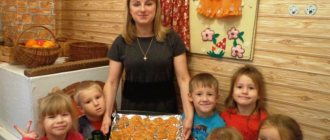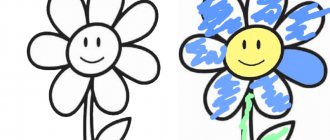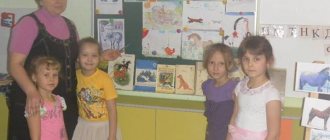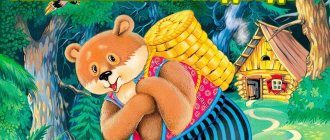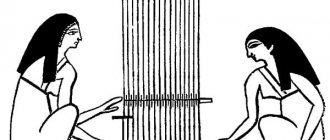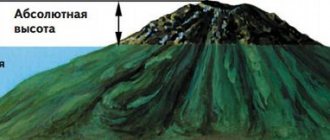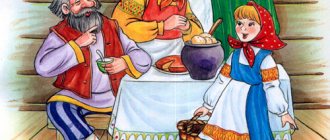Quote from missis_anchous
Read in full In your quotation book or community!
Developmental lesson based on the fairy tale “Masha and the Bear”
This lesson is intended for children 3-4 years old. Read the fairy tale “Masha and the Bear” with your child. Take the doll Masha, she goes for a walk, picks berries and mushrooms. She came to the forest, and the forest was dense. Tell your child what a dense forest is.
Let's draw a forest.
Together with your child, first draw a sparse forest - the trees are far from each other, then a dense forest - very dense, the trees are close to each other.
Finger game “Fingers in the forest” One, two, three, four, five, the fingers went out for a walk (we show our fists). This finger went into the forest (we bend the fingers one at a time, starting with the little finger), this finger found a mushroom, this one cut it, this one ate it, well, this one just looked! (at the end we tickle your palm)
Game "Find Masha"
Take your picture of a forest (mom can add flowers, mushrooms, Christmas trees). Tell the baby that Masha wants to play hide and seek with him. Invite him to find Masha in the forest and name where she hid - behind a tree, in front of a Christmas tree, to the left of the mushroom, etc.
We make berries.
Then Masha came to the forest. He sees that there are many berries growing on each bush. My child and I make raspberries (we attach a lot of red balls to each other), strawberries (we make a ball, lengthen it on one side, and make dots with a pencil). We make two baskets for Masha. Invite your child to help Masha pick berries - raspberries in one basket and strawberries in the other. We count how many berries are in each basket - where there are more, where there are fewer berries. Make some number cards: put a number in each basket that corresponds to the number of berries in it.
We develop thinking.
Masha walked and walked and saw a house. She went into it. Here you can use pictures for a flannelgraph, theatrical decorations “Home Theater” or simply draw a house. Masha got tired and sat down on a chair. What other furniture do you know? What is a table, chair, bed, etc. for?
Ball game.
Invite your child to remember what happened next. Take the ball and take turns telling a story: one sentence is a child, the other is a mother.
Let's read.
There may be several game options:
- Take cards with a picture of a girl, a bear, trees, mushrooms, a house, etc. Take letter cards. Invite your child to match the letters to the pictures - which ones they begin with.
- Play connecting games with syllables. On the left side of the sheet we draw, for example, Masha. On the right side we write various syllables - ma, yes, sha, va. We pronounce the word slowly. We invite the child to find the syllables that are in this word and cross them out.
Construction.
Invite your child to build a house for the bear. The building material can be anything - a block constructor, counting sticks, cubes, etc. We name the parts of the house - roof, chimney, window. We talk about what kind of houses there are, what material they are built from.
Game "Opposites"
Invite your child to continue the phrase: “The elephant has a big house, but the mouse has ... (small).” “The Christmas tree has prickly needles, but the leaves of the tree... (smooth).”
Mimic gymnastics.
Invite your child to show an angry bear - we raise our eyebrows, a cheerful one - we smile, a surprised one - we raise our eyebrows up. Describe the bear - clumsy, club-footed, heavy. Walk like a bear, waddling from side to side. What's Masha like? Kind, cheerful, friendly, etc.
Outdoor game “At the bear in the forest.”
Choose a bear - let it be mom, for example. The bear sleeps in his “den”. The child walks and pretends that he is picking mushrooms and berries. We say:
I take mushrooms and berries from the bear in the forest, but the bear does not sleep, and looks at us!
After these words, the bear wakes up and tries to catch up with the children. Whoever is caught becomes a bear.
Once upon a time there lived a grandfather and a grandmother. They had a granddaughter Mashenka.
Once the girlfriends got together in the forest to pick mushrooms and berries. They came to invite Mashenka with them.
“Grandfather, grandmother,” says Mashenka, “let me go into the forest with my friends!”
Grandfather and grandmother answer:
“Go, just make sure you don’t lag behind your friends, otherwise you’ll get lost.”
The girls came to the forest and began picking mushrooms and berries. Here Mashenka - tree by tree, bush by bush - and went far, far away from her friends.
She started calling around and calling them. But my girlfriends don’t hear, they don’t respond.
Mashenka walked and walked through the forest - she got completely lost.
She came to the very wilderness, to the very thicket. He sees a hut standing there. Mashenka knocked on the door - no answer. She pushed the door, the door opened.
Mashenka entered the hut and sat down on a bench by the window.
She sat down and thought:
“Who lives here? Why can’t I see anyone?..” And in that hut lived a huge bear. Only he wasn’t at home then: he was walking through the forest. The bear returned in the evening, saw Mashenka, and was delighted.
“Yeah,” he says, “now I won’t let you go!” You will live with me. You will light the stove, you will cook porridge, you will feed me porridge.
Masha pushed, grieved, but nothing could be done. She began to live with the bear in the hut.
The bear goes into the forest for the whole day, and Mashenka is told not to leave the hut without him.
“And if you leave,” he says, “I’ll catch you anyway and then I’ll eat you!”
Mashenka began to think about how she could escape from the bear. There are forests all around, he doesn’t know which way to go, there’s no one to ask...
She thought and thought and came up with an idea.
One day a bear comes from the forest, and Mashenka says to him:
“Bear, bear, let me go to the village for a day: I’ll bring gifts for grandma and grandpa.”
“No,” says the bear, “you will get lost in the forest.” Give me some gifts, I'll take them myself!
And that’s exactly what Mashenka needs!
She baked pies, took out a big, big box and said to the bear:
“Here, look: I’ll put the pies in a box, and you take them to grandpa and grandma.” Yes, remember: don’t open the box on the way, don’t take out the pies. I’ll climb up the oak tree and keep an eye on you!
“Okay,” the bear answers, “give me the box!” Mashenka says:
- Go out onto the porch and see if it’s raining! As soon as the bear came out onto the porch, Mashenka immediately climbed into the box and placed a plate of pies on her head.
The bear returned and saw that the box was ready. He put him on his back and went to the village.
A bear walks between fir trees, a bear wanders between birch trees, goes down into ravines, and up hills. He walked and walked, got tired and said:
I'll sit on a tree stump and eat a pie!
And Mashenka from the box:
See see! Don't sit on the tree stump, Don't eat the pie! Bring it to grandma, bring it to grandpa!
“Look, she’s so big-eyed,” says the bear, “she sees everything!” He picked up the box and moved on. He walked and walked and walked and walked, stopped, sat down and said:
I'll sit on a tree stump and eat a pie!
And Mashenka from the box again:
See see! Don't sit on the tree stump, Don't eat the pie! Bring it to grandma, bring it to grandpa!
The bear was surprised:
- How cunning she is! He sits high and looks far away! He got up and walked quickly.
I came to the village, found the house where my grandparents lived, and let’s knock on the gate with all our might:
- Knock-Knock! Unlock, open! I brought you some gifts from Mashenka.
And the dogs sensed the bear and rushed at him. They run and bark from all the yards.
The bear got scared, put the box at the gate and ran into the forest without looking back.
Grandfather and grandmother came out to the gate. They see that the box is standing.
- What's in the box? - says the grandmother.
And grandfather lifted the lid, looked and couldn’t believe his eyes: Mashenka was sitting in the box, alive and healthy.
Grandfather and grandmother were delighted. They began to hug Mashenka, kiss her, and call her smart.
Summary of educational activities for speech development in the second group of early age. Reading the fairy tale "Masha and the Bear"
Elena Shepeleva
Summary of educational activities for speech development in the second group of early age. Reading the fairy tale "Masha and the Bear"
Summary of educational activities for speech development in the second group of early age.
Reading the fairy tale " Masha and the Bear "
.
Direction: cognitive and speech development .
Educational field: cognition.
Direct educational activity: Reading fiction
Goal: To develop children's interest in fiction
through a fairy tale .
Educational objectives: Introduce children to Russian folk tales . Learn to emotionally perceive the content of a fairy tale , understand and evaluate the character and actions of the characters, and remember the sequence of events. Strengthen the ability to answer questions based on the text.
Developmental objectives : Develop children's ability to listen to a fairy tale , empathize with the heroes of the fairy tale ; develop mental cognitive processes, auditory and visual attention, figurative memory, figurative movements through play and dramatization; thinking, imagination, curiosity.
Educational objectives: To instill interest in Russian folk tales .
Integration of educational areas:
-preserve and strengthen the physical and mental health of children: regulate the change of activities through finger exercises and games.
– enrich children’s speech with fairy-tale vocabulary , adjectives that characterize fairy-tale characters ;
- develop free communication with peers and adults.
- to develop such qualities in children as empathy, responsiveness, justice, kindness;
Equipment: Book “ Masha and the Bear ”
, toy - bear, basket with pies
- reading Russian folk tales followed by a discussion of the characters and actions of the heroes;
- work on understanding ancient words from fairy tale ;
- examination of illustrations from Russian folk tales accompanied by conversation;
— watching video recordings of Russian folk tales according to the program ;
— P/i “At the bear in the forest ”
.
Thematic lesson “Masha and the Bear”
Hello everybody!
All children love fairy tales, and probably adults too! Therefore...for a whole month we will be studying fairy tales and stories for children!
Our first lesson will be based on everyone’s favorite fairy tale “Masha and the Bear”.
I will post the main things here on the blog. And additional materials will be located in our VKontakte group. Therefore, those who are not yet in the group are welcome to join us!
Since I conduct classes not with one child, but in a group (in the center), I will write guys. At home, as you understand, I also have a mini-group, and if we play, we all play together. In this case, I assign to the elders the role of leaders. And most of the questions about the fairy tale are no longer asked by me, but by the older children.
Thus, we practice speech skills, the ability to ask questions, and conduct a dialogue. It turns out not only games for younger children, but older children - joint games.
Therefore, this lesson, and subsequent ones, are quite suitable for children of different ages. They just need to be adapted a little.
Let's begin our journey into a fairy tale!
1. Greeting the guys, getting ready for the lesson.
Hello guys! Are you glad you came here today? We're glad! Let's clap our hands together for a fun nursery rhyme!
Children know how to clap, they don’t spare their hands. Like this, like this, like this. They don't spare their hands.
2.How well you all clapped. Do you know the fairy tale about “Masha and the Bear”? Let's remember it all together. I will tell you, and you will help me. We read a fairy tale from a book or from pictures.
3. Let's bring the heroes of our fairy tale to life on paper. Will you help me? Glue the fairy tale characters onto whatman paper (make a collage). You can take a large sheet of whatman paper, you can glue several A4 sheets with masking tape, or you can take old wallpaper. As the lesson progresses, be sure to ask questions (it’s better to call the children one at a time and let them glue the characters one by one). Pay attention to prepositions. The first character is a bear (where does the bear live? In the forest) Masha (where did Masha hide? In the box) Pies (where were they lying? Above Masha in the box) Box (where was it? Behind the bear’s back) the bear going? To the village), to whom did you go? (grandmother, grandfather), where did the bear come from? (from his house), who was the bear afraid of? (dogs). We glue it in the same order (asking questions as we go): bear, Masha behind, pies on top, seal it with a box, forest, bear's house, path, village, grandparents, dogs. *See collage application.
4. Physical education minute. We play the big bear and the little girl. We consider the concepts of “big and small”. We explain that a bear is a large animal, and a girl is small compared to a bear. Rules of the game. When an adult says “little girl” everyone squats down, when an adult says “big bear” everyone stands up and stretches their arms up.”
5.*Watch the presentation about pies (in the downloadable file). Let's play: look for pies. You will need a container with millet and pies (made of plasticine, dough or paper laminated or covered with tape). *A picture of the pie for printing is included in the game appendix. We hide the pies in the millet and invite the children to find them. There should be pies according to the number of children. We look for pies one by one.
6. An outdoor game for coordination and reaction speed. You will need a bear mask for children, a dog mask (for an adult). Rules of the game: I (an adult) will be a bear, and you will catch me. I will have a bell, I will ring it and move around the room, and you (children) will run after me and try to touch me. Now let's do it the other way around. Remember who the bear was running from in the village? That's right from dogs. I will be a dog, and you will be a bear. You will run away from me. *See “masks” appendix.
7. We hide in a box. You will need two boxes, small (for the doll) and large (so that the child can hide in it), a tray and pies (real, paper, plasticine or clay). Do you know what the box in which Masha hid was? In the fairy tale, the box is a large wicker box made from twigs. The box can be large or small. In the Fairy Tale the box is large, so the girl Masha and the pies fit in it. Why didn’t the bear notice Masha? Because Masha covered herself with a tray of pies on top and the box had a lid. Here's a look at how Masha hid in the box: we show the small box and the Masha doll, we hide the doll in the box. In this big box: let's show it. Who wants to hide in it? We hide the brave souls and cheer them on. After everyone has tried themselves in the role of Masha, we once again act out the scene with the box (small), Masha and the bear (toy).
8. Reflection. What fairy tale did we listen to? What fairy tale did we play? Who are the heroes in this fairy tale? Now let's play with massage balls, sit down and roll them over our arms and legs. We turn on relaxing music and roll balls with the children. Then an adult approaches each child and rolls the ball on his back.
9. Watch the presentation of the fairy tale “Masha and the Bear”.
10. Creativity. We show the children what a tray is. If you can get a few trays made from different materials, the kids will be delighted. Be sure to let them touch the different trays. What do they feel like? Do they differ in weight? In form? What's on them? What material are they made of? Next, we suggest making your own trays from cardboard and decorating them. We distribute cardboard ovals to the children. This is our tray. We decorate it by gluing paper circles of different colors. Then we make the filling for the pies and roll out red balls (berries). We make pies from plasticine. We give the children cakes, put berries in them and glue the cakes together like pies. Place the pies on a tray.
All materials for this lesson can be downloaded by clicking on the button below. I would be grateful if you share this activity with your friends by clicking on the social media buttons! Thank you!
Additional materials: download coloring books, crafts, pictures, audio stories and cartoons in our VKontakte group
This material is copyrighted! So if you want to share it, please link your friends to this post. Use of material on other sites and forums is possible only with my consent! Use of the material for commercial purposes is prohibited!
Summary of a lesson on speech development “Masha and the Bear” in the second junior group.
Irina Khramova
Summary of a lesson on speech development “Masha and the Bear” in the second junior group.
Summary of the lesson on speech development “ Masha and the Bear ”
.
1. Educational objectives: Continue to introduce children to Russian folk tales; strengthen the ability to answer questions based on the text.
2. Developmental tasks : Develop children’s ability to listen to a fairy tale, empathize with the heroes of the fairy tale; develop thinking , memory, expressiveness of speech .
3. Educational objectives: To instill interest in Russian folk tales.
Equipment: Book “ Masha and the Bear ”
, toy - bear.
